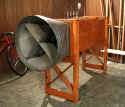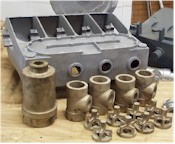 ilbur
and Orville always seemed to be building something. They were brought up to it by their
mother, Susan Koerner Wright. Her father, John Koerner, was a skilled
carriage maker
and taught his daughter to work with tools. She made many of her her own home
appliances, as well as toys for her children. More important, she passed these skills to
her children. The Wright brothers built their first flying machine, a rubber band-powered
helicopter, when Orv was 8 years old and Will was 12. Later, Orville made kites and sold
them to his friends. Wilbur invented a machine that folded the United Brethren newspaper
his father published. Together they made furniture, printing presses, bicycles,
gliders, and airplanes. Their lives seemed to revolve around their workshop. ilbur
and Orville always seemed to be building something. They were brought up to it by their
mother, Susan Koerner Wright. Her father, John Koerner, was a skilled
carriage maker
and taught his daughter to work with tools. She made many of her her own home
appliances, as well as toys for her children. More important, she passed these skills to
her children. The Wright brothers built their first flying machine, a rubber band-powered
helicopter, when Orv was 8 years old and Will was 12. Later, Orville made kites and sold
them to his friends. Wilbur invented a machine that folded the United Brethren newspaper
his father published. Together they made furniture, printing presses, bicycles,
gliders, and airplanes. Their lives seemed to revolve around their workshop.
It's no wonder that the Wright story seems to attract people who like to
work with their hands. And because of that, any Wright Brothers Museum worth the price of
admission needs a "hand on" section, a place where folks can get down and dirty
with aviation history. In this virtual workshop, we'll help you to find
plans and information for airplanes and models you would like to build.
We'll also lead you through aeronautical experiments and demonstrate some
of the skills needed to build pioneer aircraft.
|
Click
on a picture to enlarge it.

The workshop in which Will and Orv built their first airplanes now rests at the
Henry Ford Museum just outside of Detroit, Michigan.
Another one of their workshops was recently restored at 22 South Williams
Street in Dayton, Ohio. This is where they where building bicycles in 1896 when they first
became seriously interested in flight.
|
Here's what's
happening in our virtual workshop:
-
The
Box Experiment -- Wilbur
Wright was fiddling with an inner tube box in 1899 when an idea
suddenly occurred to him for an effective way to control an aircraft
in flight. Repeat the simple experiment the opened the Age of
Aviation.
Building
the 1899 Wright Kite --
Complete plans for an historic replica or a 5/8-scale easy-to-build Not
Quite Wright Kite. We also include instructions for flying the
kite. Building
the 1900 Wright Glider
-- A single sheet of plans (elevations and details) for the Wrights
first man-carrying aircraft. Building
the 1901 Wright Glider
-- A single sheet of plans (elevations and details) for the Wright's
second and most frustrating aircraft. Building
the 1901 Wright Wind Tunnel
-- Complete engineering drawings (9 sheets) for the wind tunnel, air
scoop, impeller, lift balance, drag balance, and all the known
airfoils that the Wrights used in their lift and drag experiments. Building
the 1902 Wright Glider
-- Complete
engineering drawings for the first aircraft ever with 3-axis control
-- 20 pages in all! Yours free with our fond wishes for a great
Centennial of Flight in 2003. -
Plans
and Blueprints --
Looking for plans for your Wright airplane project? We've collected a
few sources for you.
-
Model
Kits -- If you don't
want to make a Wright airplane from scratch, there are a few kits
available for sale. Here's what we've found.
-
Pioneer
Models -- We discovered
the plans for several rubber band-powered model aircraft in
ancient copies of Flying magazine. Here's what kids were
building in 1910 and 1911, when an airplane still seemed as
magical as a flying carpet.
Aircraft
Materials -- Looking for
materials from which to build Wright airplanes. We can help with
everything from cloth to engine castings.
By the way, we've constructed a special workshop in Dayton, Ohio where the public can watch
us as we build Wright aircraft. We are a "living exhibition" of
pioneer aviation at the Boonshoft
Museum of Discovery , 2600 Deweese Parkway just north of downtown Dayton.
The Boonshoft has
generously provided space for us to assemble aircraft such as the 1903
Wright Flyer 1 we will take to Kitty Hawk later in 2003 and the 1905
Wright Flyer III that will fly sometime next year. |

Our replica of the 1878 Wright Bat, made in our own
workshop.

Our replica of the 1899 Wright Kite, soaring
during the 100th anniversary of the Wright brother's kite experiment.

We've completed and test flown all three of the Wright gliders.

We've also finished a replica of the 1901 Wright
wind tunnel and balance -- and have discovered a few things the
biographers never tell you. Read the story HERE.

Need a complete set of castings for the 1903 Wright
Flyer engine? The only place on the 'net you can get 'em is right HERE.
|

